7.1: Freedom of the Press
- Page ID
- 130133
Standard 7.1: Freedom of the Press
Explain why freedom of the press was included as a right in the First Amendment to the United States Constitution and in Article 16 of the Massachusetts Constitution; explain that freedom of the press means the right to express and publish views on politics and other topics without government sponsorship, oversight, control or censorship. (Massachusetts Curriculum Framework for History and Social Studies) [8.T7.1]
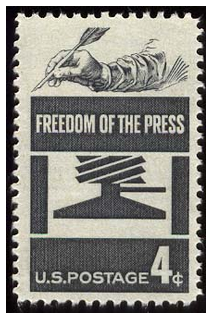
Figure \(\PageIndex{1}\): 1958 U.S. postal stamp: UNESCO encourages the "free flow of ideas by word and image" | Public domain
FOCUS QUESTION: What is the history of freedom of the press in the United States?
Freedom of the press is set forth in the First Amendment to the United States Constitution:
"Congress shall make no law respecting an establishment of religion, or prohibiting the free exercise thereof; or abridging the freedom of speech, or of the press; or the right of the people peaceably to assemble, and to petition the Government for a redress of grievances" (Amendment 1: U.S. Constitution (Freedom of Religion, Speech, Press, Assembly and Petition)).
Massachusetts has also asserted the importance of the freedom of the press in Article 16: Massachusetts Declaration of Rights (1780): "The liberty of the press is essential to the security of freedom in a state: it ought not, therefore, to be restrained in this commonwealth." The state renewed that commitment in 1948, amending its earlier language to read: "Article XVI. The liberty of the press is essential to the security of freedom in a state: it ought not, therefore, to be restrained in this commonwealth. The right of free speech shall not be abridged."
Freedom of the Press is a bedrock principle of our democratic system of government. It establishes that news reporters and news organizations must be free and unrestrained in their efforts to report events and uncover the truth. As young adult author, Linda Barrett Osborne (2020, p.1) noted of the First Amendment's protection of freedom of the press, "for more than 220 years, it has guaranteed that the federal government cannot stop news media from publishing news, ideas, and opinions, even those that disagree with the actions of presidents and lawmakers."
By contrast, totalitarian and authoritarian governments seek to control the press by dictating what can be told or shown to the people. Freedom House, a press watchdog organization, has reported that only 13% of the world's population experiences a free press (Press Freedom's Dark Horizon, 2017).
You can learn about efforts to expose and oppose news censorship from Project Censored: The News That Didn't Make the News.
A free press does not mean that everyone in the media reports the same events in the same way. Rather, a free press allows competing ideas and conflicting viewpoints to be freely expressed without censorship so people can make up their own minds based on what they see, hear, and read. The press, through print and online media, provide information in different formats beyond what is considered "objective journalism," including political analysis, editorials, editorial cartoons, and Op-Ed commentaries. Readers and viewers, especially students, need to learn and practice the skills of media literacy so they can critically evaluate the information they encounter in all forms of news media.
7.1.1 INVESTIGATE: Notable Court Cases About Freedom of the Press
Landmark court cases for freedom of the press include:
- The Peter Zenger Trial of 1735
- Near v. Minnesota (1931)
- The New York Times Co. v. Sullivan (1964)
- The New York Times Co. v. United States (1971) - also known as the Pentagon Papers case
The Peter Zenger Trial of 1735
In 1734, William Cosby, the colonial governor of New York brought a libel suit against John Peter Zenger, a printer and journalist for the New York Weekly Journal newspaper. The paper had been highly critical of the governor in print.
However, Zenger had not written the critical material but only printed it, since he was one of the few individuals with the skills to operate the printing press. At trial, Zenger was found not guilty. Although the case set no formal legal precedents, it impacted public opinion and set the stage for protections written into the Constitution and the Bill of Rights.
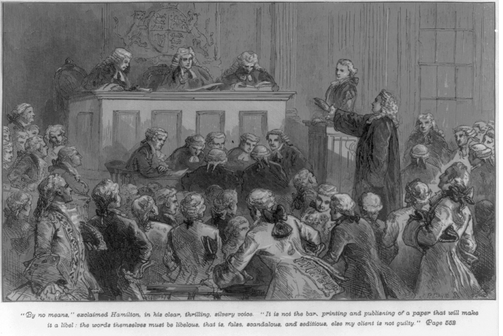
Figure \(\PageIndex{2}\): Andrew Hamilton defending John Peter Zenger in court, 1735 from Library of Congress | Public domain
Online Resources for the Peter Zenger Case
- Key primary source: A Brief Narrative of the Case and Trial of John Peter Zenger, Printer of the New York Weekly Journal by James Alexander (1972)
- Middle-grade nonfiction: The Printer's Trial: The Case of John Paul Zenger and the Fight for a Free Press By: Gail Jarrow (2006)
- Wiki page for Peter Zenger Case: Development of Colonial Governments
Near v. Minnesota (1931)
The defendant, Jay Near, published The Saturday Press, a controversial and prejudicial newspaper intended to expose corruption in government. The paper criticized and offended many important people. In 1925, he was stopped from publishing the paper and convicted in court under a Minnesota Public Nuisance Law that banned the distribution of "malicious, scandalous and defamatory" materials. Central to the case was the idea of "prior restraint," meaning the government can prevent in advance the publishing of material it considers objectionable.
The Supreme Court overturned Near's conviction, thereby establishing "a constitutional principle the doctrine that, with some narrow exceptions, the government could not censor or otherwise prohibit a publication in advance, even though the communication might be punishable after publication in a criminal or other proceeding" (Near v. Minnesota).
A more detailed summary of this case can be found at the Bill of Rights Institute.
The New York Times Co. v. Sullivan (1964)
In 1960, L. B. Sullivan, one of the leaders of the Montgomery, Alabama police force, sued the New York Times for libel (printing knowingly false and harmful information). The paper had run an advertisement from civil rights groups that included charges about police activities, some of which were exaggerated and therefore not true. Sullivan sought financial compensation for damages to his reputation.
The Supreme Court declared that the First Amendment protects the publication of statements in newspapers, even false ones, about the conduct of public officials except when the statements can be proved to have been made with "actual malice." In extending the protection of freedom of the press, the Court said, "debate on public issues should be uninhibited, robust, and wide-open" and that was more important than occasional factual errors that may appear in print.
A more detailed summary of this case can be found at the Bill of Rights Institute.
The New York Times Co. v. United States (1971)
The famous Pentagon Papers case happened when President Richard Nixon sought to block the New York Times and Washington Post newspapers from publishing classified Defense Department materials about American conduct in the Vietnam War. The papers detailed the secret involvement of the United States in the Vietnam War from 1945 to 1968, including how the presidential administrations of Harry Truman, Dwight Eisenhower, John F. Kennedy, and Lyndon Johnson deliberately deceived the American people about their policies in Southeast Asia (Nixon and the Pentagon Papers, Miller Center, University of Virginia).
A former war analyst and whistleblower, Daniel Ellsberg, had leaked the information to the press. The Nixon Administration sought to block publication, citing concerns over national security. By a 6-to-3 decision, the Supreme Court ruled against the Nixon Administration citing the Near v. Minnesota case as precedent and declaring that the government had failed to meet the "heavy burden" necessary to prevent these materials from being published.
A more detailed summary of this case can be found at the Bill of Rights Institute.
You can link here to learn more about the history of investigative journalists as whistleblowers.
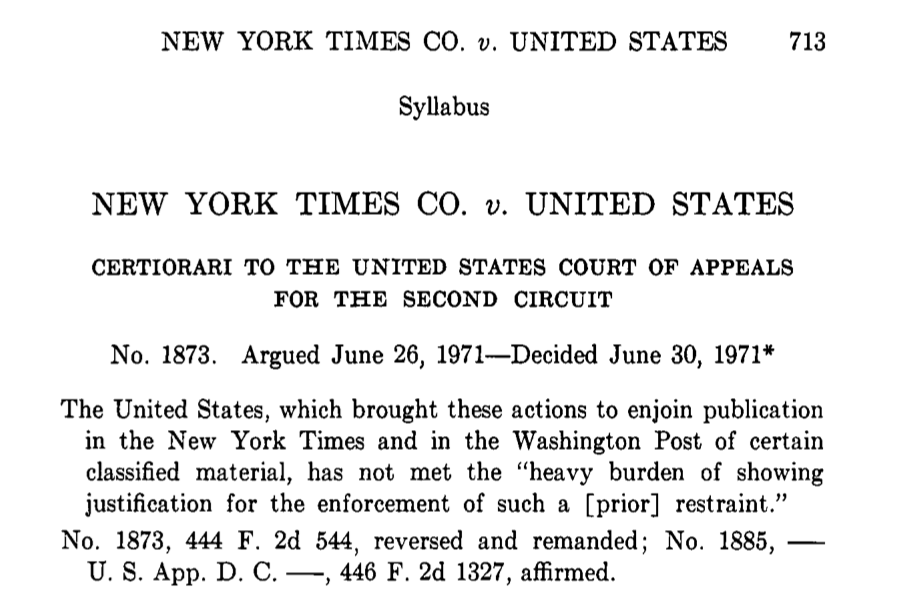
Figure \(\PageIndex{3}\): First Page of the Supreme Court Decision in New York Times Co. v. United States
Journalists and citizens have faced restrictions on the Freedom of the Press throughout United States history. Freedom of the Press is considered one of the most important American rights. Yet according to the World Press Freedom Index, the United States ranks 45th among 180 countries in terms of press freedom.
In this activity, you will act as an expert advisor tasked with helping the U.S. improve its World Press Freedom Index ranking.
- Role-play an important Freedom of the Press court case
- What are present-day parallels to the issues addressed in each case?
- How does a free and democratic society balance individual protections of privacy with the public's right to open information about government?
- As part of these investigations, consider and discuss the question: Why Does a Free Press Matter?
- Analyze data
- View data pertaining to violations of press freedoms in the U.S. Press Freedom Tracker.
- Construct an infographic or poster summarizing the results of your analysis.
Online Resources for Notable Freedom of Press Court Cases
- Historic Collection of Whistleblower Daniel Ellsberg's Life Work Acquired by the University of Massachusetts Amherst
- Learning plans
- The Importance of a Free Press - Facing History and Ourselves
- The Importance of a Free Press: Facing Ferguson - Facing History and Ourselves
- Celebrate World Press Freedom Day, Pulitzer Center (May 2018)
- The Price of a Free Press: Is Journalism Worth Dying for?, PBS
- Additional readings
- Freedom of Speech and of the Press - Heritage Foundation
- Freedom of Speech and Freedom of the Press - Lincoln University
- Video/audio
- Why press freedom is your freedom - CNN
- The Pentagon Papers: Secrets, Lies and Audiotapes: Audio Tapes from the Nixon White House - National Archives
7.1.2 UNCOVER: Censorship and the Campaign Against Comic Books in the 1950s; Book Banning in the U.S. Today; the Great Chinese Firewall
Censorship involves the "suppression of words, images or ideas" that are deemed "offensive." It happens "whenever some people succeed in imposing their personal or moral values on others" (American Civil Liberties Union, 2019). Despite the First Amendment's guarantee of freedom of expression, censorship has a long history in this country and others—and it continues today. The Campaign Against Comic Books in the 1950s and current efforts to ban books in the United States, along with the implementation of the Great Chinese Firewall, reveal the threats censorship poses to a free press and people's freedoms.
7.1.2.1 The Campaign Against Comic Books in the 1950s
The first modern comic book, Famous Funnies, was published in 1933. Superman appeared in 1938, followed in 1941 by Batman, Wonder Woman, and Captain America, collectively launching a "Golden Age" of comics that lasted into the mid-1950s. It is estimated that 90% of boys and girls in the United States were reading comic books during the 1940s.
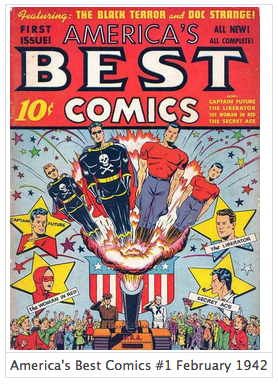
Figure \(\PageIndex{4}\): America's Best Comics Issue 1 February 1942 | Public domain
Yet, despite their popularity and readership, comic books were subject to intense opposition. There were comic book burnings and calls for greater comic book censorship appeared widely in the 1950s following the publication of Frederic Wertham's book Seduction of the Innocent: The Influence of Comic Books on Today’s Youth (1954) that held that comics cause young people to commit violent acts. Hearings by the U.S. Senate's Judiciary Committee’s Subcommittee to Investigate Juvenile Delinquency put comics and the boundaries of free speech on trial.
Examining the comic book hearings, the Comic Book Code of 1954, and ongoing efforts to ban books offers an opportunity to explore how freedom of the press can be threatened by political censorship and media pressure.
- Consider and report on the online resources listed below:
- What are your first impressions after reading, listening to and viewing these sources?
- What were the arguments for banning comic books?
- Do you agree or disagree with the ban on comic books? What is your reasoning?
- Create a comic or graphic poster about freedom of the press and/or censorship of comic books
Online Resources for the Campaign against Comic Books
- Read
- Primary Source Set: Truth, Justice and the Birth of the Superhero Comic Book from Digital Public Library of America
- Comic Books, Censorship, and Moral Panic, Mudd Manuscript Library Blog, Princeton University
- Comic Books and Censorship in the 1940s, Oxford University Press Blog
- Comic Books as Journalism: 10 Masterpieces of Graphic Nonfiction, The Atlantic, August 10, 2011
- Listen
- Senate Subcommittee on Juvenile Delinquency: Comic Books, "Soda-Pop," and Societal Harm (includes audio from the April 21, 1954 hearings)
- It’s a Bird, It’s a Plane, It’s a New Superman Bio!, NPR Fresh Air, June 18, 2012 (podcast based on Larry Tye's book, Superman: The High-Flying History of America's Most Enduring Hero). Transcript of the podcast.
- View
- Confidential File: Horror Comic Books! Television Program, October 9, 1955. Includes interview with Senator Estes Kefauver.
7.1.2.2 Banned and Challenged Books Week
Politically active groups in the United States continue to try to ban or censor books they find objectionable in theme and content. Some of the most-challenged books are: Harry Potter; To Kill a Mockingbird; The Adventures of Huckleberry Finn; Goosebumps; I Know Why The Caged Bird Sings; and Of Mice and Men. Here is a list of some 250 books that have been challenged between 2002 and 2018.
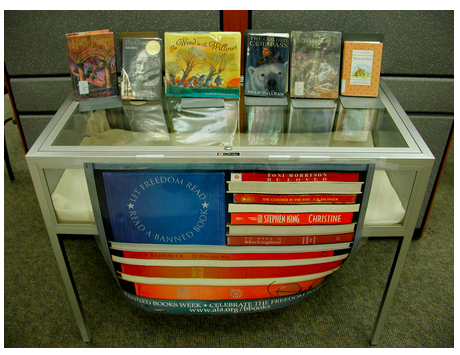
Figure \(\PageIndex{5}\): Display of Banned Books, Carmichael Library, Montevallo, Alabama, licenced under CC BY 2.0
To counteract these efforts at suppression, every year the American Library Association celebrates Banned and Challenged Books Week during the last week in September to encourage everyone to read what others seek to prevent you from reading.
- Read, summarize, and report on a book from the banned books list:
- Why was the book banned?
- What parts of the book seem controversial?
- What do you think it was banned? Do you agree with the book being banned?
- Write/Record a persuasive essay or video defending or rejecting a challenge to a book
Online Resources for Banned and Challenged Books
- Lesson Plan A Case for Reading - Examining Challenged and Banned Books, ReadWriteThink
- Get Ready to Celebrate Banned Books Week, ReadWriteThink
- Censorship: An Educator's Guide, Random House
- Banned Books Week Resources, Banned Book Week
- Top Ten Most Challenged Book List, American Library Association (2018)
- Banned Books: 10 of the Most-Challenged Books in America, BigThink (September 28, 2018)
7.1.2.3 The Great Chinese Firewall
The Great Chinese Firewall is the term given to efforts by the government of the People's Republic of China to regulate and control what information its citizens can access online. A firewall is a security system that blocks online material from coming to computers. Firewalls can block hackers, spammers, and cybercriminals from infecting individual or organizational computers, but governments can also use them to block (or censor) access to legitimate websites.
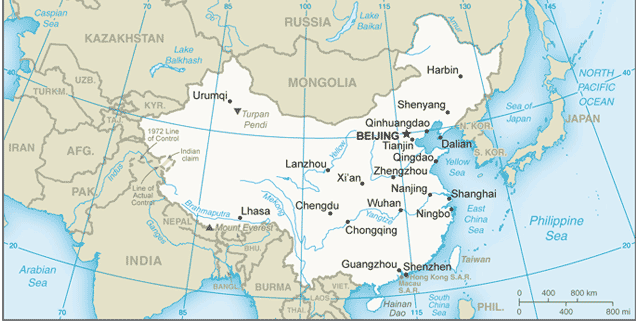
Figure \(\PageIndex{6}\): Map of China from World Factbook, 2019, CIA
To see how extensive the firewall system is in China, consider this question: "Which of the following websites do you think people in China can access?"
- www.amnesty.org.uk (Amnesty International's website about human rights)
- www.youtube.com (a social media site where people put up their own videos)
- www.chinatimes.com.tw (a Chinese website based in Taiwan)
- http://en.olympic.cn (the website of China’s Olympic Committee)
- www.Wikipedia.org (a free encyclopedia)
- www.falundafa.org (a website of the Falun Gong spiritual movement)
- www.rsf.org (ReportersWithoutBorders—an international organization which campaigns for freedom of the press)
According to Amnesty International, the only website out of this list that people in China can view is China's Olympic Committee website. The rest are blocked, along with Facebook, Twitter, Snapchat and many independent news sites (The Great Firewall of China).
CNN reporter and author James Griffiths (2019) has called China's firewall system the "most sophisticated in the world for controlling, filtering, and surveilling the internet" (The Great Firewall of China: How to Build and Control an Alternate Version of the Internet, 2019). While people in China can secretly access forbidden sites using a VPN service, the government is able to tightly control what content makes its way to smartphones, computers, and other devices in China.
The Great Chinese Firewall raises questions of how much a government (or for that matter any organization) should be allowed to control people's open access to information. Around the world, many governments restrict the flow of information to their citizens.
- State your view: How does censorship impact people in China learn about their country and the world?
- Why do you think the government of China would feel threatened by allowing open access to sites like Wikipedia, YouTube, Falun Gong or Reporters Without Borders?
- Create a digital presentation
- Use Google Slides or Powerpoint to create a presentation in response to the following question: "If you lived in a country that censored and controlled information, how would that affect your ideas, knowledge, and learning?"
Online Resources for the Great Chinese Firewall
- Press Freedom's Dark Horizon, Freedom of the Press, 2017
- 2019 World Press Freedom Index, Reporters Without Borders
- 10 Most Censored Countries, Committee to Protect Journalists (2015)
7.1.3 ENGAGE: What Are the Speech Rights of Student Journalists?
In 1983, a teacher and the principal at Hazelwood East High School in St. Louis County, Missouri refused to allow students to publish two articles they deemed offensive in the school-sponsored student newspaper. The articles dealt with divorce and teen pregnancy. The student journalists sued, claiming that the adults' censorship violated their First Amendment rights of free speech.

Figure \(\PageIndex{7}\): Girl taking note by RaphaelJeanneret from Pixabay
In the landmark case Hazelwood School District v. Kuhlmeier (1988), the Supreme Court disagreed with the students, ruling that a school newspaper was not a "forum for public expression." This ruling established that student journalists do not have the same speech and press protections as adult journalists in community settings.
In 2016, the state of Illinois expanded the press and speech rights of students with the passage the The Speech Rights of Student Journalists Act. California and Massachusetts have also passed legislation forbidding censorship of school newspapers unless the censored material would disrupt the functioning of the school.
- Record a podcast
- Listen to the podcast Education Matters - 10/06/18 featuring a discussion of the Hazelwood Case.
- Students then create their own podcast to share their thoughts and interpretations of the case.
- Engage in civic action
- Design and record a public service announcement to convince state and/or school officials to put protections in place for student journalists.
Online Resources for the Rights of Student Journalists
- States that protect student journalists
- Breaking News: Speech Rights of Student Journalists Bill is Law! - Illinois Journalism Education Association (July 29, 2016)
- NJ Bill Proposed to Prevent Schools Meddling in Student Journalism - National Coalition Against Censorship (August 1, 2016)
- Hawaii Student Free Expression Act - Proposed 2019 legislation
- Interactive exploration
- Student Reporting Labs, PBS Newshour - What is Newsworthy?; Finding Story Ideas; Facts v. Opinions; and others!
- Additional reading
- News Literacy Curriculum for Educators, American Press Institute
- Resources for High School Press Freedom and Censorship, Student Press Law Center
Standard 7.1 Conclusion
To learn about the history of freedom of the press, INVESTIGATE examined notable court cases where the rights of journalists were challenged by efforts to suppress what people could read in newspapers and other publication formats. ENGAGE looked at the rights of middle and high school student journalists. UNCOVER focused on three occasions of censorship: 1) the campaign against comic books and the enactment of the Comic Code of 1954; 2) current efforts by groups to ban books in the United States; and 3) the Great Chinese Firewall that restricts Internet access to some 800 million Chinese citizens and represents one of the greatest global threats to free expression in a digital age.

